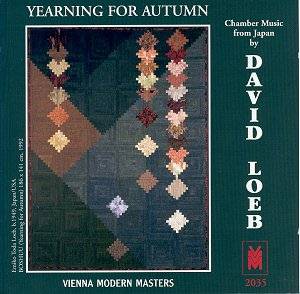This is apparently the third disc on this label devoted to
the music of David Loeb. See also VMM 2029 (Echoes from Bronze Bells)
and VMM 2033 (Imagined Landscapes).
David Loeb is American and he spells out his biography
clearly in the booklet notes, which he has written. He writes that he
was trained conventionally in New York and then in 1964 he started composing
"for early instruments (especially the viols) and composing for
East Asian instruments (mostly Japanese). Inevitably these activities
have influenced my compositions in more conventional media, in some
cases quite intentionally". He adds later "I have remained
unaffected by the peculiar succession of stylistic preoccupations which
have characterized much late twentieth century music".
This CD presents us with Loeb’s interests and work.
Its title though is misleading. The music was not really composed in
Japan (although the composer’s wife in Japanese and he regularly visits
the country), but was inspired by Japan, Japanese artists, Japanese
instruments, and Japanese culture. All of the performers are Japanese.
Two of the pieces combine Japanese and western instruments,
one piece is sung and three have Japanese images or traditions as points
of departure.
I had at first wondered if I might be encountering
another Alan Hovhaness whose inspiration was Armenia and Asia. Hovhaness
can draw a listener into his individual soundworld quite easily. Loeb
is, I’m afraid much harder work.
The most ethnic piece if I may call it that, is ‘Seiya’
for voice and Qin performed by the amazing Ryoko Niikura. Confusingly
this is more Chinese than Japanese. The poet wrote in Chinese and the
Qin is a Chinese instrument. It is difficult to believe that this piece
is not ancient music and this did lead me to fret about the whole CD.
An American composer besotted with another country writing music totally
in the language of that country. I found this and possibly still do
a worry. My faith was regenerated a little by ‘Yoru ga Mau’ for the
fascinating combination of shakuhachi, flute, koto and guitar tuned
in an unconventional manner. Mixing traditional instruments from Japan
with western ones was also attempted by Takemitsu in several works,
not least ‘November Steps’ (Philips 432 176-2) but Loeb, I feel, blends
his material more successfully. Although Asian techniques are used,
quarter-tones, slides, pentatonic passages, modality and two-part counterpoint
appear. There is also an attempt to come almost half-way towards the
western listener with its sonorities and rhythms. In the Lento third
movement there is even a hint of the blues. This is an enjoyable piece
which I have heard a number of times.
Less easy to pin down is ‘Ancient Legends’ for violin
and piano. Again a Japanese soundworld is evoked by the use of scale,
melody and glissandi but I found this work dull, annoying and colourless.
The only faster music is in the shortest movement, the third, whilst
the two preceding slower ones seem rambling and formless.
The disc opens with ‘Ganya’ for sho (which sounds a
little like a piano accordion) and viola da gamba. This did interest
me but mostly because I felt that it could be more successful as a piece
of incidental music. It is difficult to find pattern and form in this
piece. I know that it’s as much my problem as anything else but the
composer does not help. I realize that you must listen to the sounds
from beginning to end enjoying each movement in time as a colour or
a pattern and at a moment decided by the composer the sound landscape
will end.
The set of Fantasias, subtitled "Japanese Bells"
for viol consort mix a renaissance type counterpoint with Japanese scales
and textures in a highly successful manner. This is especially true
of the last of its five movements which was inspired by some "extremely
energetic and vigorous music found at the northern tip of Japan."
So this is a curious disc; a unique one in many ways.
To conclude I would have to say that there are many fascinating things
about it and many frustrating ones. I am not sure if the music will
grow on me but it is music from which to draw some inspiration and which
could be a talking point in classes with young music students.
Gary Higginson


